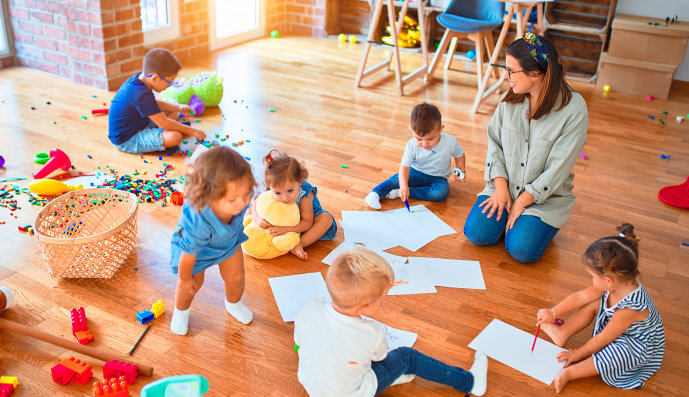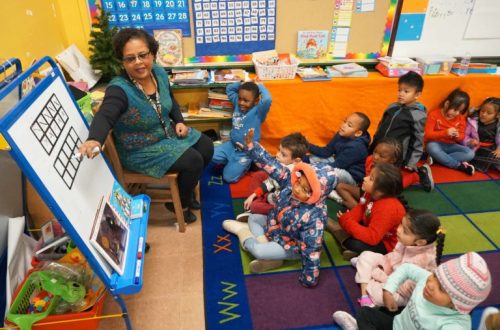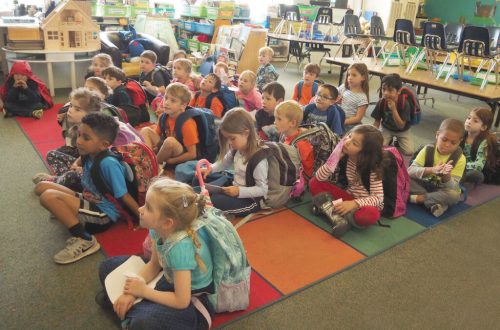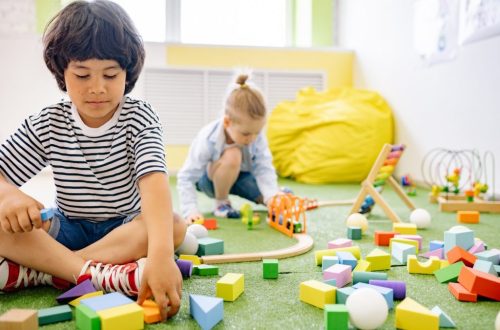
How To Teach Kindergarten Math
When teaching math to kindergartners, keep it simple. Start by counting and identifying numbers, and introduce basic addition and subtraction.One way to teach counting is to use a variety of objects, such as buttons, beads, or even pennies. Have the children count out a certain number of objects and then put them away. You can also have them identify numbers by pointing to them as you say the number aloud.To teach addition, have the children add two small piles of objects together. For subtraction, have them take away one small pile of objects from another. As they become more comfortable with addition and subtraction, gradually increase the number of objects in the piles.You can also introduce basic multiplication and division by using arrays, or grids of objects. For multiplication, have the children count how many objects are in each row and then multiply that number by the number of rows. For division, have them count how many objects are in each column and then divide that number by the number of columns.As kindergartners learn more about math, be sure to give them plenty of opportunities to practice what they have learned. Have them solve simple math problems, complete math worksheets, or play math games.
What are the 5 methods of teaching mathematics?
There are five main methods of teaching mathematics that are used in schools today. They are:1. The traditional method 2. The inquiry method 3. The problem-based method 4. The layered method 5. The mastery methodThe traditional method of teaching mathematics is the most common and is based on the teacher lecturing and students taking notes. The inquiry method is a newer method that is based on students investigating mathematical problems and conjecturing solutions. The problem-based method is also a newer method that is based on students working on real-world problems. The layered method is a newer method that is based on breaking mathematics down into smaller steps. The mastery method is a newer method that is based on students mastering a topic before moving on to the next topic.
How do you teach math in early childhood?
There is no one answer to the question of how to teach math in early childhood, as different approaches will work for different children. However, there are some general principles that can be followed in order to help young students learn math skills.One important thing to keep in mind when teaching math to young children is that it is important to make the lessons fun and engaging. This means that the lessons should be interactive and hands-on, and that students should be encouraged to explore and experiment with math concepts.Another important principle is that it is important to provide children with plenty of opportunities to practice their math skills. This can be done through games, puzzles, and other activities.Finally, it is important to be patient with young students as they learn math skills. Math can be a challenging subject for many children, and it is important to allow students to take their time and to help them if they get stuck.
What is the easiest way to teach math?
There is no easy way to teach math. Every student is different and every teacher has their own methods and strategies for teaching math. However, there are a few things that can make teaching math easier.One of the easiest ways to teach math is to use a textbook. A textbook provides a clear and concise explanation of math concepts, and it also includes practice problems and exercises.Another easy way to teach math is to use a math worksheet. A math worksheet provides a series of problems for students to solve. It can help students practice and master math concepts.Finally, teachers can use math manipulatives to help students learn math concepts. Math manipulatives are objects or tools that students can use to explore and understand math concepts. They can help students visualize and understand concepts that might be difficult to learn from a textbook or worksheet.
What maths should a 5 year old be able to do?
Maths is an important part of a child’s education, and at the age of five, they should be able to do basic maths skills. These skills can help them with everyday life, such as counting money, measuring ingredients, and calculating discounts.One of the most basic maths skills a five year old should be able to do is counting. They should be able to count forwards and backwards, identify numbers, and understand what different numbers represent.Another basic skill is addition and subtraction. A five year old should be able to add and subtract small numbers, and understand the basic concepts of these operations. For example, they should be able to understand that when you subtract two numbers, the answer is the difference between the two numbers.A five year old should also be able to understand basic multiplication and division. They should be able to multiply and divide small numbers, and understand the basic concepts of these operations. For example, they should be able to understand that when you divide two numbers, the answer is the quotient (the number of times the divisor goes into the dividend).These are just a few of the basic maths skills a five year old should be able to do. With a strong foundation in maths, they will be able to progress to more difficult concepts as they get older.
What is the easiest way to teach a child math?
One of the most important things you can do for your child is to help them learn math. It can be a challenge to teach math to young children, but there are some methods that make it easier. Here are a few tips for teaching your child math.One of the best ways to teach math is to start with concrete examples. Young children learn best when they can see and touch the objects they are learning about. So if you are teaching them about addition, start with counting objects and putting them together. Show them how to add two groups of objects together, and then let them try it themselves.Another important thing to keep in mind is that young children learn best through play. So try to incorporate math into games and activities that your child enjoys. For example, you can play games like “I Spy” or “Twenty Questions” and ask your child to solve math problems as they play. You can also make up games like “Simon Says” that require your child to follow instructions that include math problems.You can also help your child learn math by giving them opportunities to practice. Make sure your child has plenty of opportunities to solve math problems both at home and at school. You can also help them practice by giving them math worksheets to complete or math problems to solve.There are a number of different methods you can use to teach your child math. The best method for your child may vary depending on their age and level of understanding. But by using some of the tips above, you can make it easier for your child to learn math.
How do I teach my kid math in kindergarten?
When it comes to teaching math in kindergarten, there are a few basic things you can do to help your child succeed. One of the most important things is to make math fun and interactive. You can do this by using games and activities to help your child learn.Another important thing to keep in mind is to start with the basics. Make sure your child understands counting, basic addition and subtraction, and how to measure objects. Once your child has a strong foundation in these concepts, you can start to introduce more complex math concepts.One way to help your child learn is to use everyday objects to teach math concepts. For example, you can use coins to teach counting, or use measuring cups to teach measurement. You can also use math games to help your child learn. There are a number of different math games available, and many of them are easy to make at home.Finally, be sure to provide plenty of encouragement. Learning math can be challenging, but it is important for your child’s future success. Praise your child for every accomplishment, no matter how small it may seem. With a little bit of effort, you can help your child develop a love for math and a foundation for future success in math.
What age should a child be able to do math?
There is no one answer to the question of what age a child should be able to do math. Some children may be able to do basic math at a very young age, while others may not be able to do more complex math until they are older.One factor that will influence how well a child can do math is their natural ability in the subject. Some children are simply more mathematical than others, and will be able to do more complex math at an earlier age.Another factor that can influence a child’s ability to do math is their level of exposure to math. If a child is regularly exposed to math concepts at an early age, they may be able to understand and do more complex math sooner.In general, most children will be able to do basic math by the time they are in elementary school. More complex math, such as algebra and geometry, may not be mastered until middle or high school.
What are the 10 ways in teaching mathematics?
Mathematics is a subject that is often feared by students, but with the right approach, it can be a fun and interesting subject. There are many different ways to teach mathematics, but here are 10 of the most effective ways:1. Start with concrete examples When teaching a new concept, it is important to start with concrete examples. This will help students understand the concept better and will make it easier for them to apply it to other situations.2. Use manipulatives Manipulatives are objects that students can use to help them understand mathematical concepts. They can be used to represent numbers, shapes, and other mathematical concepts.3. Let students work together Working together can help students learn mathematics concepts more effectively. They can help each other understand the concepts and can come up with solutions to problems together.4. Use real-world examples Real-world examples can help students understand mathematical concepts in a practical way. This can make the concepts more meaningful to them and can help them see the relevance of mathematics in the world around them.5. Encourage students to ask questions Students should be encouraged to ask questions whenever they do not understand a concept. This will help them learn more effectively and will make the mathematics class more interactive.6. Use games and puzzles Games and puzzles can be a fun way for students to learn mathematics concepts. They can help students practice problem-solving skills and can help them develop a better understanding of mathematical concepts.7. Let students work on their own Some students learn better when they are allowed to work on their own. This allows them to take their time and to focus on the concepts that they find more difficult.8. Use different teaching methods It is important to use a variety of teaching methods in order to keep students interested in mathematics. This will help students learn in a variety of ways and will make the class more interactive.9. Challenge students Students should be challenged in mathematics class in order to help them learn more effectively. This can be done by giving them difficult problems to solve or by asking them to think about solutions in a different way.10. Make math fun Math can be a fun subject if it is taught in the right way. Students should be encouraged to explore different concepts and to find creative ways to solve problems.
Which is the best method of teaching mathematics?
There are many different methods of teaching mathematics. Which is the best one?One approach is the traditional method, where the teacher stands in front of the class and teaches the students. This method is teacher-centered and relies heavily on lecture. The students are given worksheets to do and are often tested on what they have learned.Another approach is the discovery method. In this method, the students are given a problem to solve and are allowed to work on it together. They are also allowed to ask for help from the teacher. This method is student-centered and allows the students to learn at their own pace.Which is the best method of teaching mathematics? That is a difficult question to answer. It depends on the students, the teacher, and the curriculum.
What are the 5 teaching methods?
There are five main teaching methods: lecture, demonstration, recitation, discussion, and problem solving. Each method has its own benefits and drawbacks, so it is important to choose the right one for the particular class and subject matter.The lecture method is a traditional approach that involves the teacher giving a presentation to the class. This is a good method for teaching large groups of students and for delivering complex information. However, it can be dry and boring for students, and they may not be engaged in the material.The demonstration method is used to show students how to do something. It is helpful for teaching physical skills like cooking or carpentry, or for demonstrating scientific principles. However, it can be difficult to show everything students need to know, and it can be challenging to keep students’ attention.The recitation method involves having students read or recite material aloud. This is a good way to assess students’ understanding of the material, and it can help students remember the information. However, it can be difficult to get all students to participate, and some students may not be able to read well.The discussion method encourages students to talk and share their ideas with one another. This is a good way to get students to think critically and to learn from each other. However, it can be difficult to get students to start talking, and some students may not feel comfortable speaking up in class.The problem solving method involves having students solve real-world problems. This is a good way to teach students how to apply the material they have learned to practical situations. However, it can be difficult to find good problems that are relevant to the subject matter, and it can be challenging to assess students’ progress.
What are the methods of mathematics?
Mathematics is a field of study that uses a variety of methods to solve problems. In some cases, a mathematician may use a method that is based on a theorem or a principle that has been proven. In other cases, a mathematician may use an approach that is based on a guess or a hunch. The following are some of the methods that are commonly used in mathematics:Theorem-based methods: A mathematician may use a theorem-based method to solve a problem if the problem can be broken down into a series of steps that can be proven. The mathematician may start by trying to find a theorem that can be used to solve the problem, and then he or she may use the theorem to break the problem down into smaller pieces. Once the problem is broken down, the mathematician can try to solve each piece using a theorem or a principle that has been proven.Proof-based methods: A mathematician may also use a proof-based method to solve a problem. In this case, the mathematician starts by trying to find a proof that the problem can be solved. Once the mathematician has found a proof, he or she can use the proof to solve the problem.Guess and check methods: A mathematician may also use a guess and check method to solve a problem. In this case, the mathematician starts by making a guess about how to solve the problem. He or she then checks to see if the guess solves the problem.
If it does, the mathematician stops. If the guess does not solve the problem, the mathematician makes a new guess and checks to see if it solves the problem. This process is repeated until the mathematician finds a guess that solves the problem.Hunch-based methods: A mathematician may also use a hunch-based method to solve a problem. In this case, the mathematician starts by trying to come up with a way to solve the problem. He or she then uses the hunch to solve the problem.
How do children in early childhood learn math?
Children in early childhood learn math in a variety of ways. One of the most important things is that they are exposed to math on a regular basis. This can be through everyday activities such as counting, measuring, and sorting, or through specific math lessons.One way children learn math is by counting. They learn to count objects and to count up or down. They also learn the order of numbers. This is an important skill for future math lessons.Another way children learn math is by measuring. They learn to measure length, width, and height. They also learn to compare different measurements. This is important for understanding basic geometry concepts.Children also learn math by sorting. They learn to sort objects by shape, size, color, and other attributes. This helps them understand basic concepts such as addition and subtraction.Finally, children learn math through specific math lessons. These lessons may be taught in school, or they may be taught at home. Lessons may include basic concepts such as addition and subtraction, or they may be more advanced, such as calculus.Regardless of how they learn it, math is an important skill for children to master. It helps them understand the world around them and prepares them for future math lessons.
How do you teach math in preschool?
One of the most important things you can teach preschoolers is math. Math skills are important for success in school and in life, so it’s important to start teaching them early. There are a few different ways to teach math in preschool.One way to teach math is to use concrete objects. This means using objects that children can see and touch to help them learn math concepts. For example, you could use actual counting blocks to help children learn to count. You can also use tangible objects to help children learn about shapes and sizes.Another way to teach math is to use pictures and symbols. This approach is often called abstract math. With this method, children learn math concepts by looking at pictures or symbols that represent those concepts. For example, you might use a picture of a cow to represent the number five. This approach can be a bit more challenging for preschoolers, but it can be very effective in teaching abstract concepts.The best way to teach math in preschool is to use a combination of concrete and abstract approaches. This allows children to learn in a way that is best suited to their individual learning style. It also helps to keep things interesting and engaging.If you want to teach math in preschool, start by finding out what approach works best for your child. Then use a mix of concrete and abstract activities to help them learn and grow in their math skills.
What are the 3 strategies in teaching mathematics?
There are three main strategies that can be used when teaching mathematics: direct instruction, inquiry-based instruction, and problem-based instruction.Direct instruction is a teaching strategy in which the teacher provides a step-by-step explanation of how to complete a task or solve a problem. This strategy is often used when introducing a new concept or skill.Inquiry-based instruction is a teaching strategy in which students are encouraged to explore mathematics concepts and solve problems on their own. This strategy is often used when reviewing a concept or skill.Problem-based instruction is a teaching strategy in which students are given a real-world problem to solve. This strategy is often used when applying a concept or skill.
How can I teach maths easily?
There are a variety of ways that a person can teach maths easily. One way is to use manipulatives to help students understand mathematical concepts. Manipulatives can include things like blocks, base ten blocks, dice, cards, and money. These objects can help students to visualize mathematical concepts.Another way to teach maths easily is to use games. Games can help students to learn mathematical concepts in a fun and engaging way. There are a variety of games that can be used to teach a variety of mathematical concepts.Another way to teach maths easily is to use stories. Stories can help students to understand mathematical concepts in a fun and engaging way. There are a variety of stories that can be used to teach a variety of mathematical concepts.One final way to teach maths easily is to use songs. Songs can help students to learn mathematical concepts in a fun and engaging way. There are a variety of songs that can be used to teach a variety of mathematical concepts.
Which teaching method is best for teaching mathematics?
There are many different teaching methods that can be used to teach mathematics. The best teaching method for a particular student depends on the student’s individual needs and abilities.One teaching method that is often used to teach mathematics is the direct instruction method. This method involves giving students explicit instruction on how to solve a problem. The teacher provides a step-by-step explanation of how to complete the problem, and the students follow along. This method is often used to teach students new concepts or skills.Another teaching method that can be used to teach mathematics is the discovery learning method. This method involves giving students an opportunity to explore mathematical concepts on their own. The students are given a problem to solve, and they must figure out how to solve it on their own. This method is often used to help students develop problem-solving skills.Both the direct instruction method and the discovery learning method have their benefits and drawbacks. The direct instruction method is good for students who need a lot of guidance and support, while the discovery learning method is good for students who are able to work independently. It is important to consider the individual needs of each student when deciding which teaching method to use.
What are 3 teaching strategies specific to math?
There are three main teaching strategies that are specific to math: modeling, guided practice, and independent practice.Modeling is when the teacher demonstrates how to solve a math problem. This can be done using a real-world example, or by using a visual aid, such as a diagram or a video. Guided practice is when the teacher helps students complete a math problem step-by-step. This is done by providing students with guidance and feedback. Independent practice is when students complete a math problem on their own. This allows students to practice and master the skills they have learned.




